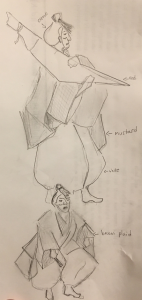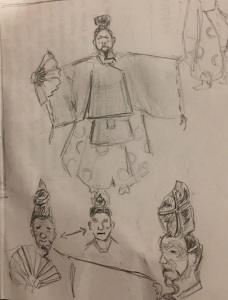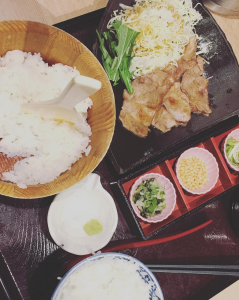I really enjoyed today’s performance, more so than I thought I would. The description of the Noh program made me wary especially with the amount of time that needed to be devoted. I was determined not to fall asleep and decided not to wake up early like I normally do. I was able to make it through the first two parts. I however missed the Kyogen as I thought it was time for the short break, and by the time I realized it wasn’t break time, Niwatorimuko was over. I did slightly worse in the “staying awake” department for Toboku, but I was awaken briefly out of excitement to sketch the priestess’ costume. I also tried not to feel too bad for getting knocked out as a quick look around revealed a good chunk of people were out cold from the Okina, and a little over half of the audience on the second floor were gone, never to be seen again. As Bethe-sensei described the day before, by the time you make it through the first 4 segments, you become more receptive to the (final) Demon Play, Iwafune, as it is short and sweet (as least we forget, signals the ending). This was especially true, and I was actually quite disappointed when the final segment ended quickly. I cant believe I’m saying this, but I wished the play was longer! Yumiyawata
Yumiyawata
The part I enjoyed the most was watching the costumes come alive through the movement and dance of the performers. This was an element I thought was intrinsic to the value of Noh, and while I could go look at pictures of Noh costumes, I wouldn’t be able to see them in action. I had thought that the bulkiness of the costumes would have obscured the slow and precise movements made by the shite actors, but it did the opposite by accentuating and exaggerating their movements. The cloth of the costume appeared stiff, and with the at times painstakingly slow movements, the actors appeared like little dolls or plastic figurines, which contributed to the fantastical aura of the play. I like the mixture of slow and calculated movements and the way actors sometimes zipped across the stage. The presentation of the costumes was also quite purposeful, as I noticed at one point a stagehand sliding across the floor to fix the slightest upturn of a fold, an imperfection I wouldn’t have noticed if he hadn’t drawn attention to it.

Okina
I had also noticed that costumes were chosen to match masks, such as in Yumiyawata, when the shite actor who donned the brown mask with the white eyebrows had worn a brown costume with white embellishments. The actor who played the Priestess in Toboku also wore a purplish costume, which reminded me of the colour of plums, which I thought was quite fitting. Speaking of Colours, I had noticed that the entrance curtain was made of 5 coloured panels and I had wondered if the colours had any meaning. I was able to ask Bethe-sensei afterwards, and she told me that each colour stood to represent one of the 5 categories of Noh. Lastly, It’s so easy to forget that the actors before you are real people, after an otherworldly performance that places a veil between us and them. While Noh performers are obviously people with their own lives, it was still interesting to see one of the stage hands outside sifting around in the trunk of his Honda Civic, still in costume. 
After the performance I went with some of the others to Kyoto Tower, and we had dinner. I had a grilled beef set with sashimi and roe.

